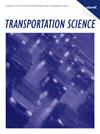物理世界中的停车搜索:利用物理和图理论方法计算搜索时间
IF 4.8
2区 工程技术
Q1 OPERATIONS RESEARCH & MANAGEMENT SCIENCE
引用次数: 1
摘要
停车在交通政策中发挥着核心作用,并产生了广泛的影响:尽管在许多西方城市,每个司机每年花在寻找停车位上的平均时间超过了几十小时,但相关的巡航交通通过排放污染物和加剧拥堵,产生了重大的外部性。然而,管理停车搜索时间的法律在许多方面仍然不透明,这阻碍了对问题及其决定因素的一般理解。在这里,我们将停车搜索问题框定在一个非常通用的,但数学上紧凑的公式中,将重点放在街道网络的作用和停车位的不平等吸引力上。这个问题可以通过两种独立的方式解决,适用于任何街道网络和广泛的驾驶员行为。在数值上,这是通过一种计算效率高且通用的基于代理的模型来完成的。在分析上,我们利用统计物理和图论的机制推导出一个通用的平均场关系,给出停车搜索时间作为停车位占用率的函数;在稳定状态下,得到了后者的表达式。我们证明,这些理论结果既适用于玩具网络,也适用于复杂的现实案例,如法国里昂市的大规模街道网络。总的来说,这些发现澄清了直接控制搜索时间的参数,并为交通工程师提供了对停车问题的定量把握。此外,它们在现实环境中的停车问题与物理问题之间建立了正式的联系。本研究由IDEXLYON资助(IDEXLYON 2020-2021);复杂系统研究所(ixi) (vulnerability)。补充材料:电子伴侣可在https://doi.org/10.1287/trsc.2023.1206上获得。本文章由计算机程序翻译,如有差异,请以英文原文为准。
Parking Search in the Physical World: Calculating the Search Time by Leveraging Physical and Graph Theoretical Methods
Parking plays a central role in transport policies and has wide-ranging consequences: While the average time spent searching for parking exceeds dozens of hours per driver every year in many Western cities, the associated cruising traffic generates major externalities, by emitting pollutants and contributing to congestion. However, the laws governing the parking search time remain opaque in many regards, which hinders any general understanding of the problem and its determinants. Here, we frame the problem of parking search in a very generic, but mathematically compact formulation that puts the focus on the role of the street network and the unequal attractiveness of parking spaces. This problem is solved in two independent ways, valid in any street network and for a wide range of drivers’ behaviours. Numerically, this is done by means of a computationally efficient and versatile agent-based model. Analytically, we leverage the machinery of Statistical Physics and Graph Theory to derive a generic mean-field relation giving the parking search time as a function of the occupancy of parking spaces; an expression for the latter is obtained in the stationary regime. We show that these theoretical results are applicable in toy networks as well as in complex, realistic cases such as the large-scale street network of the city of Lyon, France. Taken as a whole, these findings clarify the parameters that directly control the search time and provide transport engineers with a quantitative grasp of the parking problem. Besides, they establish formal connections between the parking issue in realistic settings and physical problems. Funding: This work was supported by IDEXLYON (IDEXLYON 2020–2021); Institut Rhonalpin des Systèmes Complexes (IXXI) (Vulnerabilite). Supplemental Material: The e-companion is available at https://doi.org/10.1287/trsc.2023.1206 .
求助全文
通过发布文献求助,成功后即可免费获取论文全文。
去求助
来源期刊

Transportation Science
工程技术-运筹学与管理科学
CiteScore
8.30
自引率
10.90%
发文量
111
审稿时长
12 months
期刊介绍:
Transportation Science, published quarterly by INFORMS, is the flagship journal of the Transportation Science and Logistics Society of INFORMS. As the foremost scientific journal in the cross-disciplinary operational research field of transportation analysis, Transportation Science publishes high-quality original contributions and surveys on phenomena associated with all modes of transportation, present and prospective, including mainly all levels of planning, design, economic, operational, and social aspects. Transportation Science focuses primarily on fundamental theories, coupled with observational and experimental studies of transportation and logistics phenomena and processes, mathematical models, advanced methodologies and novel applications in transportation and logistics systems analysis, planning and design. The journal covers a broad range of topics that include vehicular and human traffic flow theories, models and their application to traffic operations and management, strategic, tactical, and operational planning of transportation and logistics systems; performance analysis methods and system design and optimization; theories and analysis methods for network and spatial activity interaction, equilibrium and dynamics; economics of transportation system supply and evaluation; methodologies for analysis of transportation user behavior and the demand for transportation and logistics services.
Transportation Science is international in scope, with editors from nations around the globe. The editorial board reflects the diverse interdisciplinary interests of the transportation science and logistics community, with members that hold primary affiliations in engineering (civil, industrial, and aeronautical), physics, economics, applied mathematics, and business.
 求助内容:
求助内容: 应助结果提醒方式:
应助结果提醒方式:


